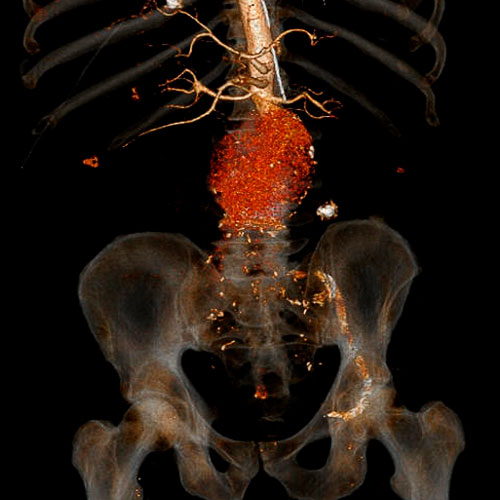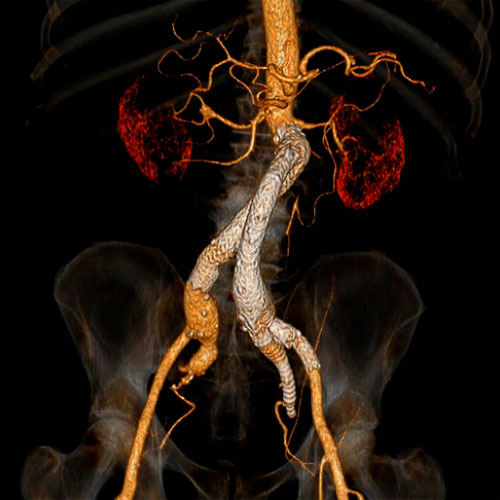Awake During an Aortic Aneurysm Repair
February 01, 2023

Jack Minor thought he’d heard it all until he lay awake in the vascular suite at University Hospitals Cleveland Medical Center, talking to his endovascular surgeon while the surgeon repaired three ruptured aneurysms in Jack’s body.
William Yoon, MD, a vascular surgeon with UH Harrington Heart & Vascular Institute, used only a local anesthetic and accessed the aortic aneurysm in Jack’s trunk and two iliac aneurysms in his pelvis through openings in Jack’s groin. Dr. Yoon avoided general anesthesia in order to keep Jack’s blood pressure stable. He completed the entire emergent repair of this 8-centimeter-long aneurysm in under an hour.
“When you have heart failure and a ruptured aneurysm, mortality can be very high,” Dr. Yoon said. “But we were able to save him.”

Minimally invasive endovascular aneurysm repair (EVAR) is ideal for patients with complicated medical issues whose bodies would not fare as well with major open surgery. Dr. Yoon said it is not uncommon for a patient to have significant coronary artery disease (CAD), heart failure and an abdominal aortic aneurysm (AAA) all at the same time as Jack did.
“In this situation, patient management becomes challenging,” Dr. Yoon said. “With coronary bypass surgery prior to AAA repair, the risk of AAA rupture will significantly increase postoperatively. On the other hand, if the AAA repair is carried out first, the sudden change in hemodynamic status will have a detrimental effect on cardiac function. Performing two procedures in a patient like Jack with multiple comorbidities and an open heart surgery history (triple cardiac bypass) may be too invasive.
“Ruptured AAA is a surgical emergency requiring immediate open or endovascular repair. Without treatment, the mortality rate approaches 100 percent.”
A Shot to the Back
Jack was stringing Christmas lights outside his Parma bungalow the week before Thanksgiving when back pain forced him to stop. He had trouble moving as he went inside the house and into the bathroom. A sharp pain in his back suddenly brought him to the ground.
“Boom, it was like I was shot, I swear,” Jack recalled. “My back was killing me.”
He didn’t want his wife to call 9-1-1, but fortunately for him the retired nurse did not listen. Jack was taken to a community hospital, where a CT scan confirmed he had multiple ruptured aneurysms. He was swiftly transferred to UH Cleveland Medical Center, where vascular specialists waited to do an emergency procedure on him.
“When I heard it was an aneurysm, I thought ‘Wait a minute, that’s what killed my grandpa and my uncle,’” said Jack, who underwent a triple cardiac bypass surgery at the age of 59. “I got very concerned. It’s hereditary, I guess.”
A Special Technique
Dr. Yoon was recruited to UH Harrington Heart & Vascular Institute for his advanced approach for complex endovascular aortic repairs. He is fellowship-trained in vascular surgery, advanced aortic surgery and advanced aortic endovascular surgery.
“With recent advances in endovascular techniques, the use of EVAR over open surgical repair has rapidly increased because EVAR is less invasive,” Dr. Yoon said.

EVAR is performed via a small incision in the bilateral femoral artery in the groin. Through this incision, a graft is inserted into the aorta to strengthen it, reduce the risk of bleeding and avoid opening the chest. The minimally invasive procedure results in less stress on the patient.
“In open repair surgery, cross-clamping of the abdominal aorta is necessary, which increases systemic vascular resistance and left ventricular wall stress,” Dr. Yoon said. “EVAR in the setting of ruptured AAA minimizes physiologic stress and decreases the risk of subsequent cardiovascular, pulmonary and renal morbidity. Thus, the best option for this patient was EVAR, which can be performed without cross-clamping of the abdominal aorta under local anesthesia. Most of all, the hemodynamic change is negligible owing to the absence of aortic clamping. This allows high-risk patients like Jack to tolerate the procedure well.”
Jack’s case required EVAR with iliac branch endoprosthesis (IBE), which is used in the lower section of the abdominal aorta with iliac artery involvement. But when an aneurysm involves the upper abdominal aorta where the renal arteries branch off to the kidneys, the traditional stent-graft can block renal blood flow, Dr. Yoon explained.
“In these complex aortic cases, we use a stent graft with fenestrations/branches to preserve blood flow, known as fenestrated EVAR or FEVAR/branched EVAR,” Dr. Yoon said. “This allows endovascular treatment for patients who previously were not EVAR candidates.”
Dr. Yoon recounted a recent case where a patient’s aneurysm involved the entire abdominal aorta, involving all four critical aortic branch arteries: the celiac trunk, superior mesenteric artery, and right and left renal arteries, which supply the stomach, liver, large and small intestine, and kidneys. Because this patient also was at high risk for open surgery like Jack, Dr. Yoon performed a four-vessel FEVAR, and the surgery was a success.
“We’re proud to offer advanced cutting-edge endovascular technology to the communities we serve,” Dr. Yoon said.


